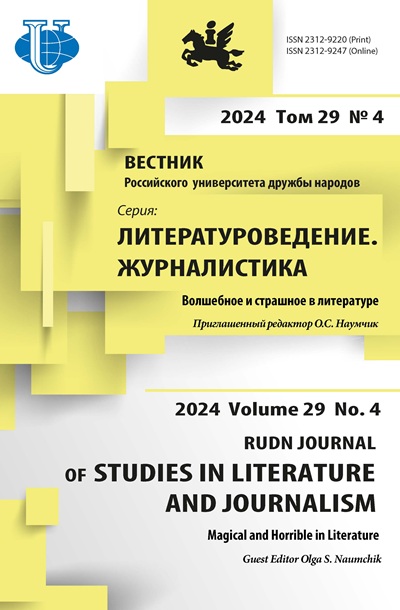The theme of the North in modern Russian folk-horror
- Authors: Safron E.A.1
-
Affiliations:
- Petrozavodsk State University
- Issue: Vol 29, No 4 (2024): MAGICAL AND HORRIBLE IN LITERATURE
- Pages: 703-710
- Section: LITERARY CRITICISM
- URL: https://journals.rudn.ru/literary-criticism/article/view/42290
- DOI: https://doi.org/10.22363/2312-9220-2024-29-4-703-710
- EDN: https://elibrary.ru/QIDDTQ
Cite item
Full Text
Abstract
Examines the specifics of the implementation of the North theme in the subgenre of modern domestic folk horror using the example of novels and stories by D. Bobyleva, O. Kozhin, L. Lvova, A. Podolsky, M. Romanova. The geography of the North in folk horror includes Karelia, the Arkhangelsk region, Siberia and Yakutia. The work was carried out using motive, cultural-historical, historical-genetic methods. It turns out that this subgenre is built on the basis of the chronotope of locations remote from large cities (towns, villages, settlements), which are associated with the chthonic world and threaten people (the motif of a cursed place). An obligatory element of the poetics of folk horror is the depiction of heroes who are carriers of a pagan worldview: shamans, priests, sorcerers, and the plot is initiatory: an individual, encountering supernatural beings (whose genesis is folkloremythological in nature), joins the archaic culture and becomes its full-fledged part. The author comes to the conclusion that not only supernatural creatures are dangerous to humans, but also nature itself: heroes risk drowning in a swamp, freezing during a snowstorm, etc. Fulfilling the requirements of the genre, writers frighten the reader and make him feel disgust, but at the same time they convey the special attractiveness of the North, reproducing the customs and rituals of autochthonous peoples.
Keywords
About the authors
Elena A. Safron
Petrozavodsk State University
Author for correspondence.
Email: 00inane@gmail.com
ORCID iD: 0000-0002-7752-3403
доктор филологических наук, профессор кафедры германской филологии и скандинавистики
Petrozavodsk, Russian FederationReferences
















